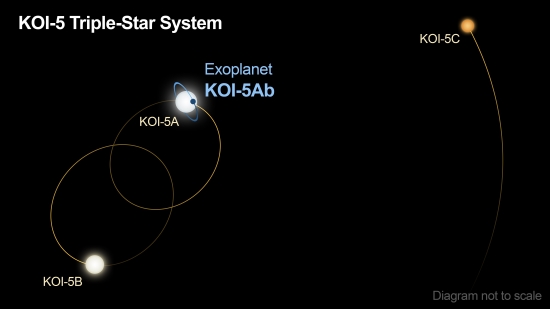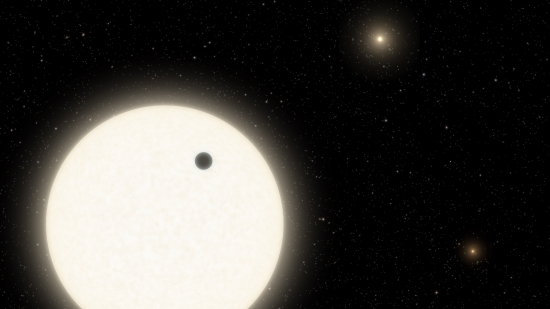The Kepler mission produced so much data — 2394 exoplanets, 2366 candidates by the end of spacecraft operations in 2018 — that we might forget how quickly all this came about. The first Kepler results started being announced in 2010. One of these, the second candidate to emerge, was KOI-5Ab, which was a tough pick in the early going given its position within a triple star system. An ambiguous detection, it was soon left behind, its status uncertain, as the numbers of more definitive candidates swelled. Caltech’s David Ciardi, who discussed this elusive system at the recent virtual meeting of the American Astronomical Society, says this about it:
“KOI-5Ab got abandoned because it was complicated, and we had thousands of candidates. There were easier pickings than KOI-5Ab, and we were learning something new from Kepler every day, so that KOI-5 was mostly forgotten.”
Ciardi, who is chief scientist at NASA’s Exoplanet Science Institute, has now pulled KOI-5Ab back to vibrant life. Almost certainly a gas giant, the planet orbits one of three stars in the system in a misaligned orbit that calls into question the nature of its formation. Making original confirmation of the planet difficult was the inability to completely distinguish it from the possible effects of the other two stars in the system. Untangling the question would involve TESS data. The object appears in TESS terminology as TOI-1241b, showing a five-day orbit that matches the Kepler result.
Confirming such a candidate calls for more than a single backup asset on the ground. Working with colleagues in the California Planet Search, Ciardi used Keck data, as well as observations from Caltech’s Palomar Observatory near San Diego and Gemini North in Hawaii, though the scientist credits TESS as the motivation for re-visiting the object. We learn that KOI-5Ab orbits Star A, whose companion, Star B, is in a tight 30 year orbit with A. The third star orbits A and B every 400 years. Have a look at the image below to see the orbital dance.

Image: The KOI-5 star system consists of three stars, labeled A, B, and C in this diagram. Star A and B orbit each other every 30 years. Star C orbits stars A and B every 400 years. The system hosts one known planet, called KOI-5Ab, which was discovered and characterized using data from NASA’s Kepler and TESS (Transiting Exoplanet Survey Satellite) missions, as well as ground-based telescopes. KOI-5Ab is about half the mass of Saturn and orbits star A roughly every five days. Its orbit is titled 50 degrees relative to the plane of stars A and B. Astronomers suspect that this misaligned orbit was caused by star B, which gravitationally kicked the planet during its development, skewing its orbit and causing it to migrate inward. Credit: Caltech/R. Hurt (IPAC).
The orbital mechanics in play as planets formed from a primordial disk could account for the misalignment, given the gravitational influence of the second star, causing the planet to migrate inward as well as skewing its inclination. There are similar cases of misaligned orbits — particular GW Orionis — offering evidence of distortions caused by multiple star system evolution.
“We don’t know of many planets that exist in triple-star systems, and this one is extra special because its orbit is skewed,” adds Ciardi. “We still have a lot of questions about how and when planets can form in multiple-star systems and how their properties compare to planets in single-star systems. By studying this system in greater detail, perhaps we can gain insight into how the universe makes planets.”

Image: This artist’s concept shows the planet KOI-5Ab transiting across the face of a sun-like star, which is part of a triple-star system located 1,800 light-years away in the constellation Cygnus. Credit: Caltech/R. Hurt (IPAC).



This system looks like it’s a fair analog of the Alpha Centauri system. KOI5A and 5B are at a similar distance to Alpha Centauri A & B and they have their rotational axies misaligned with their co-orbital plane like ACA and ACB.
I would be interested if the planet’s orbit is aligned with the equator of KOI5A.
There’s an opening for a number of questions which I do not know if we have a solid answer to yet:
How many star systems include a red dwarf sun, be they single, double, triple, or more? And what does that mean exactly in terms of the evolution of star systems? And how might it affect any worlds in such systems with life on them?
What is interesting about this is the planet is it is really close to it’s parent star which makes sense, but any planets which are too close to the barycenter of the two inner stars would have a too unstable orbit to form there according to Kippenhahn’s no planets can form around double stars idea in the 100 Billion Suns book. It looks like the idea might only be partially true. I wonder how far apart are KOI-5 A and B in miles or AU.
There is a preprint at https://arxiv.org/pdf/1505.02814.pdf which deduced that if this planet orbited KOI-5A, then it should have eccentricity between 0.05 and 0.27. That seemed odd enough to them at the time that they thought it orbited KOI-5B so it could have zero eccentricity. This reminds me of something I saw in the Wikipedia article about Planet Nine, where the role of either a giant planet or a passing star was considered for explaining the clustering of objects in inclined eccentric orbits. Could the presence of KOI-5B have an effect like that?